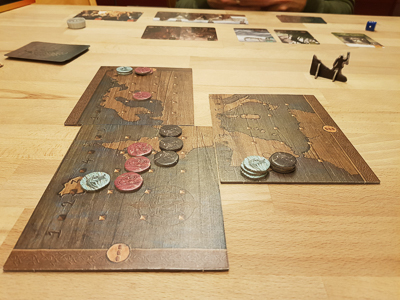

![[IMAGE]](../bilder/lindis1.png) |
Authors: Publisher: No. of Players: |
![[IMAGE]](../technik/box/rot/rot-4.gif) ![[IMAGE]](../technik/box/gelb/gelb-8.gif) ![[IMAGE]](../technik/box/grun/grun-7.gif) ![[IMAGE]](../technik/box/pink/pink-6.gif) ![[IMAGE]](../technik/box/blau/blau-7.gif) |
|
G@mebox author Lutz Wildt writes about the game:
I'm actually a landlubber. But sometimes I feel the need to get on a boat and make a little boat trip. In my area there are a few lakes where you can rent pedal boats. At least that's a start. I would also like to make a journey in a houseboat, let's say on the Shannon. But at the moment I have no time to do so. Fortunately, I found another possibility to make a small boat tour. Even if the outcome of this special boat trip is incalculable, because it takes place in a very dark and threatening time. I'm speaking about the Middle Ages, when ship journeys were often uncomfortable and fraught with danger. Especially if you were on a Viking ship attacking the monastery Lindisfarne in the year 793.
 Yes, in the game Lindisfarne players control the fate of a Viking clan. As raiders of the sea they try to bring the most prestige to their clans by attacking the countries of western Europe. The game comprises 6 of these expeditions, each one with several rounds, and two actions for every player per round. The gameboard is composed of three parts and represents a nautical map. So, prepare to depart and return to the village. A player who wants to depart must roll as many dice as he has Viking tokens, and chooses at least one die for one of the three boards by placing a Viking token on this board below the corresponding die value. If he is the first player to do so, he places his token on the open line that is the furthest north. If he is already present on the board, new tokens are added to the same line, and if a die value is already occupied, the new token is stacked up the previous one. When the first player has finished, the next player rolls the dice, and so on.  All players only get 6 Viking tokens at the beginning of the game, so the more tokens a players uses in one round, the fewer dice he can roll in his next turn. Adding the tokens is a struggle for supremacy on all three boards. The scoring of the boards takes place, when all players have returned to the village (which ends the expedition). There are two returning options. Either a player decides to return at his or her own request, gaining him or her one rune token (these tokens may modify a die result by +/-1) for every Viking token he has left this round (the first player to do so will be the new fist player for the next round), or a player is forced to return, because he has no Viking tokens left. The leading player is determined for every single board. On the first board the player with the highest total becomes the leader, on the second board the player with the longest suit in the same line and on the third board the one with the highest stack of tokens. Players will harvest the fruits of their labour at the end of an expedition by choosing one of the corresponding two destination cards from the board or by drawing two objective cards, picking one instead. These cards bring the prestige to the clans. Some cards also support the Vikings, immediately or at certain situations. Other cards have special effects at the end of the game. There are also cards that score prestige points by creating a fresco or fulfilling an objective. The game ends after the 6th expedition with the player with most prestige points wining the game.  I liked playing Lindisfarne a lot. First, the game caught my attention just because of the great artwork. But later I realised that this game is also an awesome mixture of a dice rolling and set collection game. Now that I have played Lindisfarne in a wide variety of constellations, I can say that my first impression has been fully confirmed. In the first rounds you can't estimate exactly how and to what extent you should place your dice, but after a short time you develop a strategy, which you have to adjust again and again due to the tactics of your opponents. In the course of the game a player learns the value of the cards, which can be seized by his robberies. However, I must say that the two-player variant of Lindisfarne cannot compete with a three- or four-player game. This is mainly due to the fact that, with a neutral player, the use of the dice in the two variants is too static and the moves of the two remaining players are too easy to predict. The game material is by and large fantastic. Only the dice didn't really convince me. In my opinion they don't fit in with the game theme because of their unpretentious appearance. I would much better like cubes in Viking style. But that's really whining on a high level, because apart from that the game is really great. In this context it is worth mentioning that on the back of the three game boards you can find a scoreboard and a help for the accounting, a really good idea. In conclusion, I can only say that my first impression at SPIEL 18 has been fully confirmed: RUNES EDITIONS did a great job publishing this small game in such a little box. My needs for sea voyages are now satisfied for the time being, let's see what we can do on land in the near future. | ||
|
| ||

|
|

|
|
| ||
|
Impressum / Contact Info / Disclaimer Kulkmann@aol.com
Copyright © 2019 Ralf Togler & Frank Schulte-Kulkmann, Essen, Germany | ||